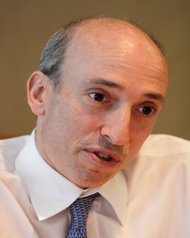Starting this week, the White House will kick off a six-month campaign to persuade millions of uninsured Americans to sign up for health coverage as part of insurance marketplaces that open for business on Oct. 1. If too few people enroll, the centerpiece of the president’s Affordable Care Act could collapse.
But instead of offering the kind of grudging cooperation that normally follows even the most bitter of legislative battles, Mr. Obama’s foes have intensified their opposition, trying to deepen the nation’s anger about the health insurance program, which both sides often call Obamacare.
Across the country, Republicans are eager to prevent people from enrolling, fearing that once people begin receiving the benefit they will be loath to give it up. And in Washington, lawmakers have cast the law as the evil villain in a legislative melodrama about the budget that is barreling toward another government shutdown.
One group called Generation Opportunity distributed a Web video last week showing a creepy-looking Uncle Sam peering between a woman’s legs at a gynecologist’s office.
“Don’t let government play doctor,” the video says at the end. “Opt out of Obamacare.”
In the face of the intense opposition, the White House is pushing ahead with a vigorous public relations effort that will begin accelerating Monday, according to top White House aides in charge of the program.
Officials said the rollout would include a presidential event this week in New York with former President Bill Clinton and a health care speech by Mr. Obama on Thursday in Maryland. Michelle Obama will urge mothers and veterans to enroll their families. Vice President Joseph R. Biden Jr. will host a nationwide conference call with nurses to enlist them in the effort to spread the word. Members of the president’s cabinet will fan out across the country, lobbying constituent groups to prod their members into action.
Those efforts will eventually be augmented by a Madison Avenue-style advertising campaign by insurance companies, which officials say are poised to spend $1 billion or more to attract millions of new customers. Some of the ads are likely to be aimed at young people, many of whom are uninsured but healthy — and great for the insurance companies’ bottom line.
Liberal advocacy groups have also begun to organize door-to-door canvassing, much as they did on behalf of Mr. Obama’s two presidential campaigns.
The overarching goal is to persuade many of today’s 48 million uninsured to sign up for insurance on the new exchanges created by the law. Crucially, officials need to woo older, sicker people without insurance as well as younger, healthier people, whose payments effectively subsidize those who will end up using more health care. Mr. Obama’s organizing strength among young adults — whom he won by a wide margin in 2008 and 2012 — may aid the campaign.
“We will have to create buzz and engagement and adjust and reach people in a sustained way from October to the end of March,” said Tara McGuinness, who is leading the health care communications effort inside the White House. “This is about what makes sense for families, what’s affordable for them.”
But even as Mr. Obama’s campaign accelerates, Republicans at all political levels are working against the law.
The Republican National Committee has begun what it calls a monthlong awareness campaign, with a television booking operation to make sure that pundits opposed to the law are always available to counter its boosters. The committee’s effort has already booked local and national politicians on radio programs like “The Hugh Hewitt Show” and cable TV programs like “The Mike Huckabee Show.”
A Republican committee Web site counts down the days, hours, minutes and seconds until what it calls the “Obamacare Train Wreck.”
Other conservative groups are broadcasting television advertisements that urge people not to sign up for coverage under the health care law. Americans for Prosperity began broadcasting an ad last week featuring a cancer survivor who warns about the dangers of the law. It is the latest in a series of commercials featuring women criticizing the law.
“Obamacare is dangerous — it can’t be implemented,” Tricia, the cancer survivor, says in the ad. “Your well-being judged by a bureaucrat in D.C. is devastating.”
Republican state and local officials are trying to thwart the administration’s enrollment efforts by imposing restrictions and requirements on volunteers seeking to inform people about how to enroll in coverage plans under the law. The Heritage Action Fund organized a Defund Obamacare bus tour this summer that helped convince House Republicans that no federal budget deal should be made without stripping the money from the health law.
And in Congress, House Republicans are threatening to shut down the government and risk a default unless Congress eliminates all of the financing for the law, effectively killing it.

Article source: http://www.nytimes.com/2013/09/22/us/politics/reignited-battle-over-health-law.html?partner=rss&emc=rss



